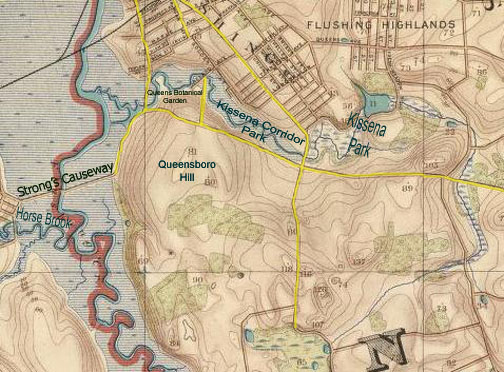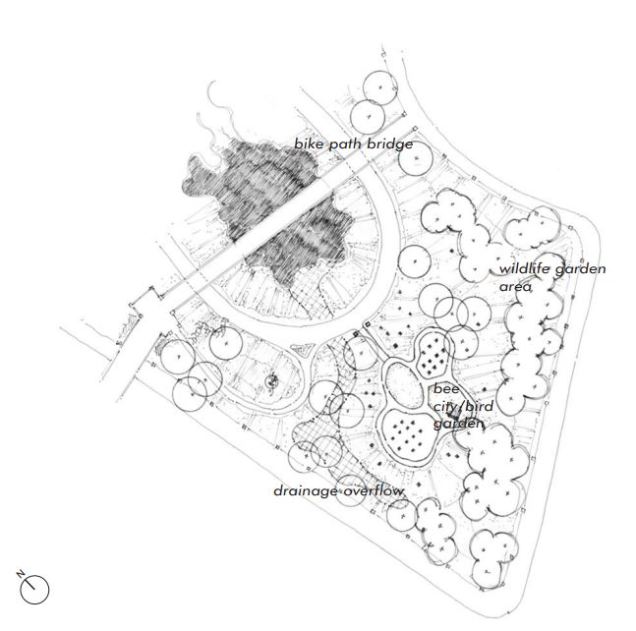Ask a native New Yorker where one can find the city’s largest botanical garden, and the answer is outside of Manhattan. The same goes for the city’s largest zoo and largest city-operated park. In a measure of the limited independence that the city’s other four boroughs feel, each has its own zoo, art museum, and botanical garden.
By definition, a botanical garden is a collection of diverse plant species from many climates, locations and habitats. This includes sandy deserts and wetlands (saltwater and freshwater). In places where there are no natural streams, the botanical gardens carve out waterways that appear naturalistic and plant wetland flora along their banks.
One such example is the Queens Botanical Garden in Flushing, which has an artificial stream running through its property, which itself is a landfill covering a natural stream running through a sewer deep beneath the surface.
In 2002, the Queens Botanical Garden released a Master Plan that celebrated the connection between water, botany and culture around the world. It celebrates the diversity of Queens and seeks to enhance and expand the attractions offered by QBG.
According to the Master Plan, a stream would emerge near the park’s main entrance at Main Street, collect rainwater flowing from the rooftop of the Administration Building, and flow west through the Wedding Garden, Horticultural Heritage Garden, Children’s Garden, Senior Garden, prairie, and terminating in a wetland at the park’s western border. It would also collect rainwater from the parking lot and swale, reducing its dependence on the city aqueduct. By traveling through so many of the QBG’s units, it would unify the disparate sections of the 39-acre property.
Botany in Flushing, Queens
Although the New York Botanical Garden in the Bronx, founded in 1891 is the oldest in the city, botanical research in New York actually had its start in Flushing, where in 1735, William Prince established a nursery. Its location is in today’s downtown Flushing, remembered only by Prince Street and the obscure Linneaus Place.
In 1838, Samuel Parsons began his nursery in what is now the northern part of Kissena Park. His sons, Samuel Bowne Parsons and Robert Bowne Parsons, brought to the nursery numerous plant species from abroad. Among his customers were Central Park designers Frederick Law Olmsted and Calvert Vaux. In one former section of Parsons’ garden, streets were laid out with plant names in an A through Q grid: Ash, Beech, Cherry… ending with Oak, Poplar, Quince. Parsons Boulevard runs through the neighborhood. Another section of the former nursery is today the Historic Grove of Kissena Park.
How QBG Began
The 1939-1940 World’s Fair in Flushing Meadows was a celebration of the city, the states, the county, and other countries. As part of the local element, it had the Gardens on Parade exhibit. It was best remembered for its fancy sculptural gateway.

The five-acre garden opened on May 18, 1939. The exhibit was located on the bank of the Flushing Creek, just south of Tidal Gate Bridge. It contained 29 units, and following the fair, was maintained by volunteers. It expanded to 15 acres in 1954.
In 1963, the garden was relocated in advance of the 1964 New York World’s Fair, to a new site within Kissena Corridor Park.
Kissena Creek on the QBG Site
Prior to its development by the QBG, the section of Kissena Corridor Park was an undeveloped parkland mapped by Robert Moses along the route of the abandoned Central Railroad of Long Island, which briefly ran between Flushing and Farmingdale rom 1872 to 1879. The line followed a stream known as Kissena Creek, or Mill Creek. The stream was also paralleled by North Hempstead Plank Road, known today as Booth Memorial Avenue. On the 1891 Bien Atlas below, other highlighted routes include College Point Boulevard, Main Street and Kissena Boulevard which cross the creek.

Between 1940 and 1954, the stream was buried using fill from the construction of the Long Island Expressway. New playgrounds were built along the edges of Kissena Corridor Park, but most of the filled stream bed remained undeveloped.

The QBG on its new site
The site opened in 1963 as the new Queens Botanical Garden. In its first three decades, it encompassed less than half of the property, with the rest of the block serving as a public park.
The first phase of the 2001 Master Plan, is the environmentally friendly Administration Building, completed in 2008 at the cost of $12 million. Designed by the Manhattan-based BKSK Architects, the building has the platinum rating from the U.S. Green Building Council’s Leadership in Energy and Environmental Design program.

Along with the rooftop, another source of water for the QBG’s waterway was a sculpture-like fountain between the main entrance and the Pin Oak Allee.
Another element of the first phase of the Master Plan that has been completed is the Parking Garden, where permeable paving absorbs water, which is filtered through the earth and wetland plants.
Looking Ahead
In comparison to the generously funded botanical gardens in the Bronx and Brooklyn, QBG has always struggled to match its ambitions. The introduction of environmentally friendly postmodern design to the QBG has earned it international attention, which could help attract donors in order to enable the Master Plan to proceed to its next phase. At this time, all of the QBG’s patrons enter the property through its Parking Garden or Main Gate, with the bridge connecting to Flushing Meadows padlocked.

It is a shame, considering that the bridge leads to the borough’s largest park, home to the Queens’ leading cultural institutions. In the 2001 Master Plan, the architects proposed extending the bridge above the QBG’s Wetland Garden, giving travelers a free view of the site. The bridge would be part of the Brooklyn-Queens Greenway, a continuous bike route that runs mostly through park properties, but not through the QBG, where it runs along its periphery on local streets.

Unfortunately, financial realities appear to have scaled down the ambitious western entrance plan and a more modest design was submitted in 2011, eliminating the bridge that would have spanned the garden.
So For Now…
For now, the western half of the QBG remains mostly untouched as funding is sought to advance the Master Plan. The only part of the garden’s stream that is a reality is a short section running past the Administration Building and within the Wedding Garden. It is the only hint of what was once Kissena Creek flowing through the QBG.

In contrast to the QBG, the New York Botanical Garden is bisected by the Bronx River; the Brooklyn Botanical Garden has its own artificial stream and a Japanese-style pond; the Staten Island Botanical Garden at Snug Harbor has Harbor Brook.
As for Manhattan, the city’s flagship borough does not have an eponymous botanical garden, but it does have the Conservatory Garden in Central Park and the Heather Garden at Fort Tryon Park as its leading botanical attractions.
In the News: The iconic Sixth Street Viaduct above the Los Angeles River is coming down, to be replaced with a more contemporary design.
Wednesday Reading
As today is Wednesday, I would like to share some stream-related reading materials. Since childhood, I’ve been a devoted reader of National Geographic Magazine, collecting enough copies to fill a bookshelf and hanging its poster maps on my walls while my classmates had sports and music stars on their walls. Its two most recent issues show that in an age of declining print publications, NG refuses to go down quietly, kicking off 2016 with a plenty to digest on parks and urban history.
For its January edition, the magazine celebrates the positive value of parks on the human psyche. As a staffer at NYC Parks, it’s the type of cover worthy of hanging on my office wall, right by my CCNY diploma. For February, the magazine scraped beneath London’s Streets, uncovering not only centuries of urban history, but also one of the city’s oldest hidden urban streams, the River Walbrook. When London was a modest Roman outpost, the Walbrook supplied water to its residents, but also served as an open sewer.
The magazine’s online edition has more information on hidden urban streams, documenting 11 of them around the world in partnership with urban spelunker Steve Duncan.
Although the Hudson is certainly not a hidden river, as a New Yorker, I feel proud whenever it appears in the Magazine, for example:

March 1962, above. January 1978, below.

March 1996, below.

As a subscriber, I have access to the online scans of every edition going back to 1888. If that alone is not a reason to support the research and journalism of National Geographic, then I don’t know what is.








6 thoughts on “Queens Botanical Garden”